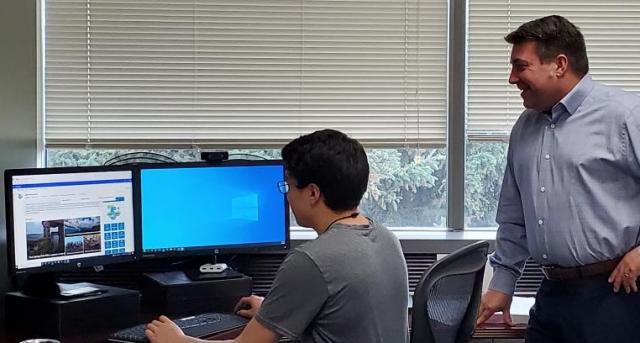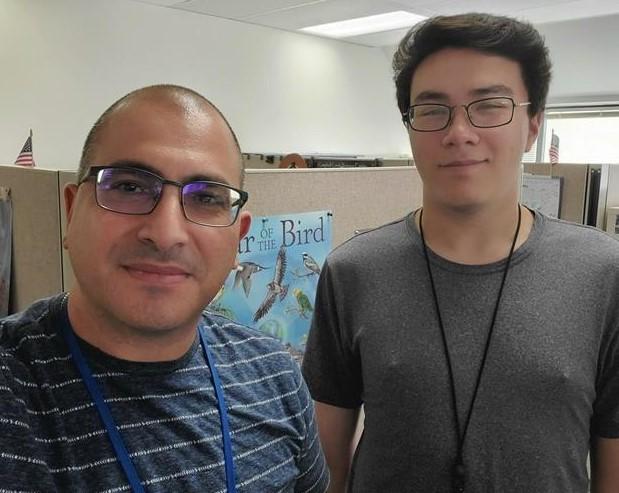You are viewing ARCHIVED content published online before January 20, 2025. Please note that this content is NOT UPDATED, and links may not work. Additionally, any previously issued diversity, equity, inclusion or gender-related guidance on this webpage should be considered rescinded. For current information, visit https://www.blm.gov/blog.
Peaking behind BLM curtain gives high school grads rare collegiate and career insights

Freshman Anand Egan was starting his computer science program at the University of Alaska in Fairbanks this fall, thinking he wanted “something to do with computers.” But he says he didn’t know – not really. He’s smart, but how could he know? Like many headed to college, the choice he faced was a risk, perhaps even a gamble, since he had no actual experience in the field.
But who’s going to let a freshly minted high school grad into their information technology (aka “IT”) department to sit with desktop support and system engineers, work on servers, wire switches, deploy computers, and troubleshoot computer issues for employees...inside secure firewalls... just to see if they like it? Not happening.
Unless, of course, you’re talking about the Bureau of Land Management Alaska’s partnership with the Alaska Native Science & Engineering Program’s Summer Bridge Program. In that case, they even get paid for it.
Beginning with elementary school, ANSEP aims to prepare Alaska students for higher education and careers through academic, social, and professional development. The aptly named Summer Bridge internship spans six to nine weeks of the summer between high school and college for those interested in engineering, science, or business careers. Successful completion can even mean University of Alaska scholarship funding.
“It’s a good way to see If you really want the job you ‘want,’” said Egan, an 18-year-old from the Matanuska-Susitna, or “Mat-Su,” Valley about an hour northeast of Anchorage. “I got to test the water for what IT feels like in a real environment with real experience I can add to a resume.”
Neal Therrien, currently BLM Alaska’s acting associate deputy state director for support services and formerly its desktop support supervisor for southern Alaska, drove the partnership and got the first ANSEP IT intern in 2017.
“In addition to helping students understand what it’s like to work in the field, we plant seeds about future opportunities with BLM and other federal agencies while in student status and beyond graduation,” he said, noting that the experience also helps employees. “They must know the skills well enough to teach others, and they may also learn new perspectives from the students.”
Therrien says positive feedback from the students and assistance from the bureau’s National Operations Center have ensured continued participation and success with the program.
“For the student syllabus, we adopted the primary technical checklist used by the NOC’s Customer Relations Management Branch to standardize training for all new desktop support technicians,” he said. ”And the NOC supports having its IT specialist assigned to us provide the training.”
“The other key is customer service,” Therrien continued. “We demonstrate exceptional customer service, so the student walks away with a solid technical and customer service baseline. IT specialists, like Eddy Haroun who has the ability and patience to teach others, are worth their weight in gold.”
Haroun, the NOC IT specialist supporting BLM Alaska from the state office in Anchorage, says the focus on customers first drives him and is what he drives home for students.
“If our customers feel better, they work better,” said Haroun, who began his own career at BLM Alaska as a volunteer and credits his performance during that period for the job he has now. “We can’t put stress on them because they’re already stressed. I feel like our job is to make other people’s lives easier.”
Haroun gave Egan a lot of reading, taught him the basics, and demonstrated how to do the work. Then he gave the student a supervised go of it.

“Read, watch, do, check, verify.” Haroun repeated the process like a mantra.
He says that to help Egan gain the most knowledge and build his resume, he gave him the widest spectrum of experience, including programming, network engineering, troubleshooting, providing in-person support to the state director, providing customer service, and demonstrating processes, as well as getting big ‘thank yous’ from customers (optional on the resume).
“Mornings were tough for Anand,” Haroun joked, “But, he’s a very smart guy. He was working a lot: loading laptops, deploying laptops, changing the active directory.
“I always welcomed him here to not be afraid to try things,” he said. “We gave him the confidence to touch, to try, and to learn – that’s the goal of this program. “
But was that goal reached?
“Eddy let me get a hands-on experience instead of just watching. Once he let me start doing things, it was great,” Egan said. “I was really surprised how important IT is in a workplace. If you can’t get an IT issue resolved, then that employee can’t do his or her work.”
So is the newly minted high school grad now more certain about his career and collegiate path?
“The experience will look really good on my resume when applying for jobs,” he said, and he’s looking forward to his freshman year in computer science.
That sounds like a “yes.”
Eric Tausch, Public Affairs Specialist
Related Stories
- Overcoming challenges to move the BLM forward: Nikki Haskett
- BLM Recreation Sites Available to All: Exploring Accessibility on Alaska’s Public Lands
- A boatload of recreational opportunities
- Exploring the Campbell Tract Special Recreation Management Area: Flora, fauna, and volunteer opportunities
- Far more than a few beavers
